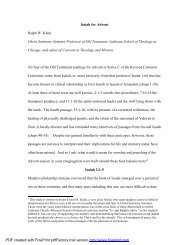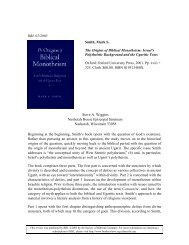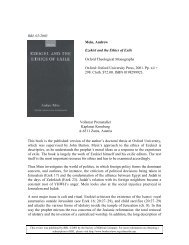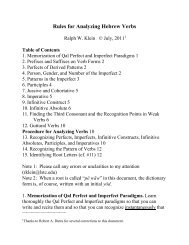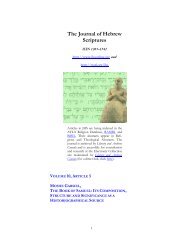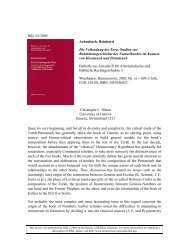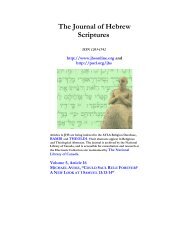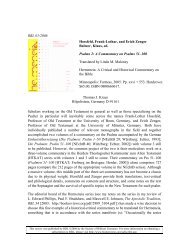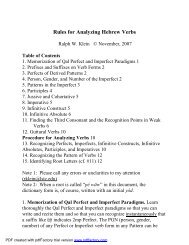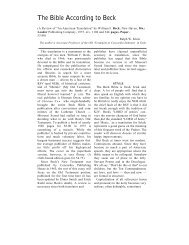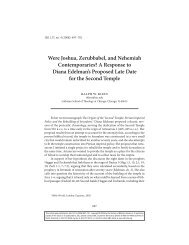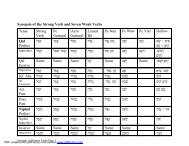RBL 03/2005 Nissinen, Marti, C. L. Seow, and Robert K. Ritner ...
RBL 03/2005 Nissinen, Marti, C. L. Seow, and Robert K. Ritner ...
RBL 03/2005 Nissinen, Marti, C. L. Seow, and Robert K. Ritner ...
Create successful ePaper yourself
Turn your PDF publications into a flip-book with our unique Google optimized e-Paper software.
Section 4 includes twenty-nine Nineveh oracles found in the remains of the royal Neo-<br />
Assyrian archive of Nineveh that was destroyed in 612 B.C.E. by the Babylonians <strong>and</strong><br />
Medes. The prophetic texts appear on two types of tablets, some of which are recorded<br />
individually <strong>and</strong> others that are collected together. The first represent a type of disposable<br />
document that was apparently used for an initial recording; the second was intended for<br />
long-term preservation. Some might see in this the origins of the writing of prophetic<br />
books, although the biblical books appear to have been more highly stylized to present an<br />
overall interpretation of the prophet <strong>and</strong> his times than the Neo-Assyrian collections<br />
would suggest. The documents were collected only by Kings Esarhaddon <strong>and</strong><br />
Assurbanipal, which suggests to <strong>Nissinen</strong> that they were the only kings to have<br />
prophecies filed away. We must be aware that these are the last kings of Assyria. We<br />
therefore cannot exclude the possibility that similar collections were made by earlier<br />
kings, either to be discarded later or simply not housed in Assurbanipal’s archives.<br />
Nevertheless, <strong>Nissinen</strong> notes that they are also the only Assyrian kings to be attentive to<br />
prophecy, which may be relevant for the emergence of classical prophecy in Israel during<br />
this period. The words of various deities appear throughout these documents, including<br />
Ishtar of Arbela, Bel, <strong>and</strong> Nabu, among others. The addressee is generally the king of<br />
Assyria, which points to a similar social role for prophets as that presented in the Mari<br />
letters. They cover a similar range of topics, <strong>and</strong> they emphasize the deliverance of šulmu<br />
oracles of well-being to the king in his various enterprises. The reassurance formula,<br />
“fear not!” appears frequently in these oracles as well as in biblical texts.<br />
Section 5 includes twenty-three other Neo-Assyrian documents that are relevant to the<br />
study of Mesopotamian prophecy. Documents include royal inscriptions, a succession<br />
treaty for Esarhaddon, royal correspondence, the so-called Marduk ordeal, administrative<br />
texts, <strong>and</strong> so forth. The royal oracles show strong support of the gods for Esarhaddon <strong>and</strong><br />
Assurbanipal. The Marduk ordeal was apparently related to the return of Marduk’s statue<br />
to Babylon <strong>and</strong> the rebuilding of the city at the beginning of Assurbanipal’s reign,<br />
although Assurbanipal probably regretted his decision when Babylon revolted in 652–<br />
648!<br />
Section 6 includes seventeen (not sixteen, as mentioned on 179) miscellaneous cuneiform<br />
sources, such as lexical lists, temple offerings, chronographic texts, omen texts, <strong>and</strong> the<br />
like. All refer in one form or another to prophets. The righteous sufferer from Ugarit is<br />
particularly important for its description of the prophets who bathe in their blood,<br />
apparently at mourning ceremonies. Such a text might help to explain the actions of<br />
Elijah’s opponents at Mount Carmel (1 Kgs 18).<br />
Section 7 includes six West Semitic texts prepared by C. L. <strong>Seow</strong>, including the Amman<br />
Citadel Inscription, the Zakkur Stele, the Deir ‘Alla text, <strong>and</strong> three Lachish ostraca. The<br />
This review was published by <strong>RBL</strong> ©<strong>2005</strong> by the Society of Biblical Literature. For more information on obtaining a<br />
subscription to <strong>RBL</strong>, please visit http://www.bookreviews.org/subscribe.asp.





